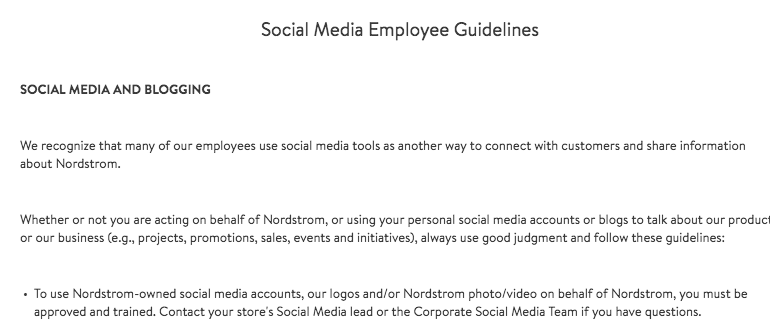How To Build a Thorough Social Media Policy to Prevent Emergencies
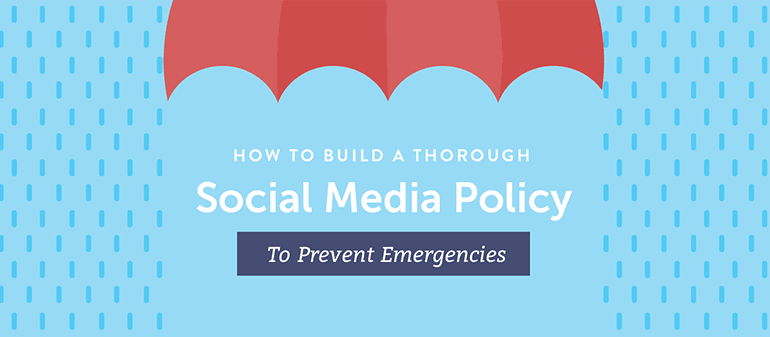 When it comes to social media, how companies set internal policies can be a gray area.
For example, questions like, “Am I allowed to be on Facebook at work?” are becoming as common as “how much time do I get off a year?” Being able to easily answer those questions is where having a clear and easy-to-follow social media policy comes into play.
By clearing up ambiguity and defining in black and white what is acceptable social media behavior for your organization, you can answer those questions before they come up, and avoid costly social media mistakes.
In this post, we’ll help clear up those murky waters by showing you:
When it comes to social media, how companies set internal policies can be a gray area.
For example, questions like, “Am I allowed to be on Facebook at work?” are becoming as common as “how much time do I get off a year?” Being able to easily answer those questions is where having a clear and easy-to-follow social media policy comes into play.
By clearing up ambiguity and defining in black and white what is acceptable social media behavior for your organization, you can answer those questions before they come up, and avoid costly social media mistakes.
In this post, we’ll help clear up those murky waters by showing you:
- How to create social media guidelines for your business. Having guidelines will help your employees understand what is acceptable social behavior. Knowing what’s appropriate and not appropriate will help avoid those blunders that could not only create a scandal for the company but cost an employee their job.
- How to create a living social media policy document. Having a living social media policy document is the key to keeping your company’s social media image healthy and stable. Not only that but having a document that is constantly updated with the most recent social media guidelines will give your employees something to rely on when it comes to answering those ever-changing social media questions.
- How to approach the conversation about social media policy with your employees. Having a conversation about social media and its reach inside and outside company time is hard. However, establishing those guidelines and having those conversations are what will help your employees and your company avoid disasters later down the road.
How To Build a Thorough Social Media Policy to Prevent Emergencies
Click To TweetBefore We Start: Grab Your Free Social Media Policy Template
Before you continue reading, download our Social Media Policy Template, which will walk you through how to create your own social media policy. By the time you’re done, you’ll have your own policy to hand off to your employees.Start By Explaining Why You Need a Social Media Policy
The first thing that you are going to see when you open your social media policy template is a section dedicated to answering the following question:Why does this social media policy exist and why should your employees care about it?Outlining why you have your policy will help your employees understand what they can do to help promote the company, help them avoid creating social media disasters, and make sure that you don’t lose a potentially great employee based on one instance of poor judgment.
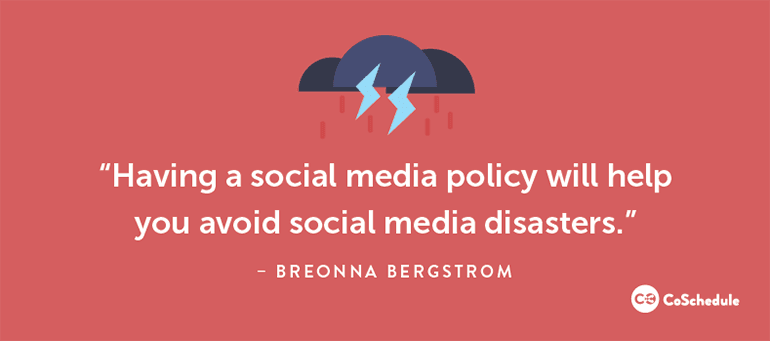 In your social media template, we’ve outlined a basic answer to the “why does this policy exist?” question. However, feel free to adjust your answer based on your company guidelines and expectations.
In your social media template, we’ve outlined a basic answer to the “why does this policy exist?” question. However, feel free to adjust your answer based on your company guidelines and expectations.
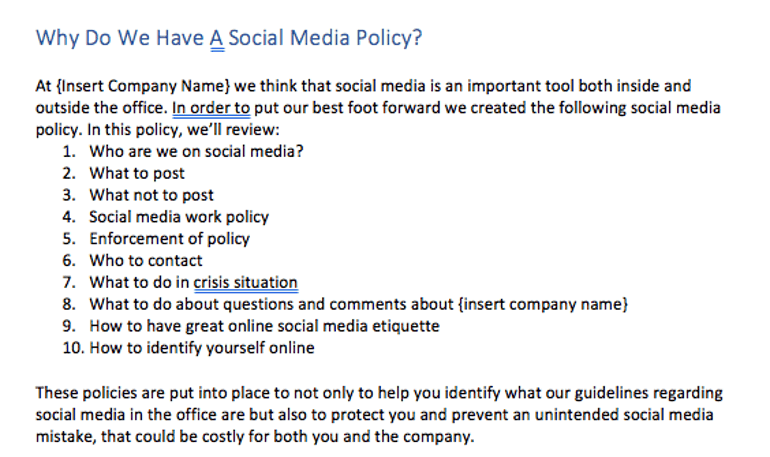
Who Are We On Social Media?
Your company probably has a set of core values or guiding principles that you operate by. These values are at the heart of everything you do. Those values don’t have to stop once your employees leave the office, either. They can be a part of their personal social media posts as well. At CoSchedule we live by:- Being passionate about our product
- Never settling for good enough
- Getting sh*t done
- Thinking big
- Great design
- Personalized customer service
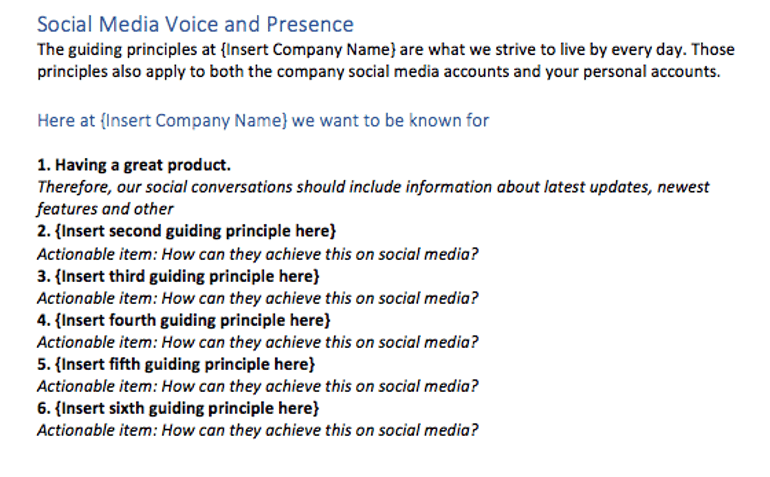
How To Set Expectations For Your Employees
The best way for your employees to understand what they can and cannot post on social is to be as clear as possible with your expectations. For the next part of your social media policy template, we’re going to focus on how to clearly define those expectations.Determining What Your Employees Should Post
Determining what your employees should post is crucial to the success of your social media presence. When you’re thinking of what your employees should post, be as clear and specific as you can. The more you explain, the fewer questions you’ll have down the road. So for an example, let’s pretend a hypothetical theater company was working on a list of appropriate topics their employees could post. It might look something like this:- Upcoming auditions
- Upcoming shows
- Company news (once approved by board for release to public)
- Job or artistic openings
- Industry news
- Rehearsal photos
- Company outings
- Local events
- Local theater productions
- Behind the scenes/ backstage photos
Determining Post Topics Your Employees Should Avoid
Most of the items that you would encourage your employees to be cautious posting about are pretty self-explanatory and should be common sense areas to avoid. However, clear instructions will help guide your employees and create fewer questions down the road. So let’s go back to our social media policy template and see what an example looks like:- Politics
- Religion
- Sensitive audition information
- Company finances
- Costumes or set photos (unless permission has been given by the designer)
- Speculations about upcoming season shows
- Negative reviews of actors, directors or other artists
- Negative reviews of local theaters
- Gossip or other inflammatory language
- Derogatory language about someone’s gender, religion, heritage, sexual orientation or disability
Freedom Of Speech Versus Company Policy: Which One Wins?
Trying to tell employees what they can post on their social accounts is the definition of a gray area. It is their personal account, after all, they are entitled to their own opinions. Well, while you are entitled to your own opinions, that doesn’t mean that you or your employees are free from the backlash of a poorly worded tweet. Yes, freedom of speech is important, but just like in the real world where you represent your company at all times, you also represent your company on social media at all times.You represent your company on social media at all times.
Click To Tweet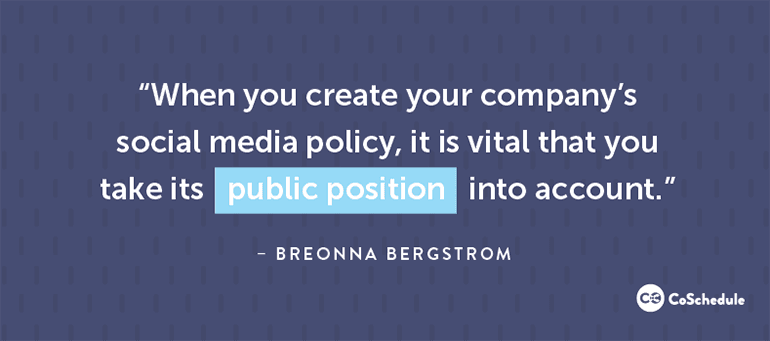 While you can encourage employees to stay away from discussing certain topics on social media, it is important to note that you cannot, according to the National Labor Relations Board, restrict people from discussing things like wages or working conditions among other things. If you’re in doubt about something, consult your legal team. You never want to feel like you’re squashing your employees with your social media policy, but you also want to protect yourself, and them!
Now there’s a trend that says if you put a disclaimer in your bio like “opinions are my own” or “retweets do not equal endorsements” then your content is safe from employer backlash and your company is safe from public backlash.
While you can encourage employees to stay away from discussing certain topics on social media, it is important to note that you cannot, according to the National Labor Relations Board, restrict people from discussing things like wages or working conditions among other things. If you’re in doubt about something, consult your legal team. You never want to feel like you’re squashing your employees with your social media policy, but you also want to protect yourself, and them!
Now there’s a trend that says if you put a disclaimer in your bio like “opinions are my own” or “retweets do not equal endorsements” then your content is safe from employer backlash and your company is safe from public backlash.
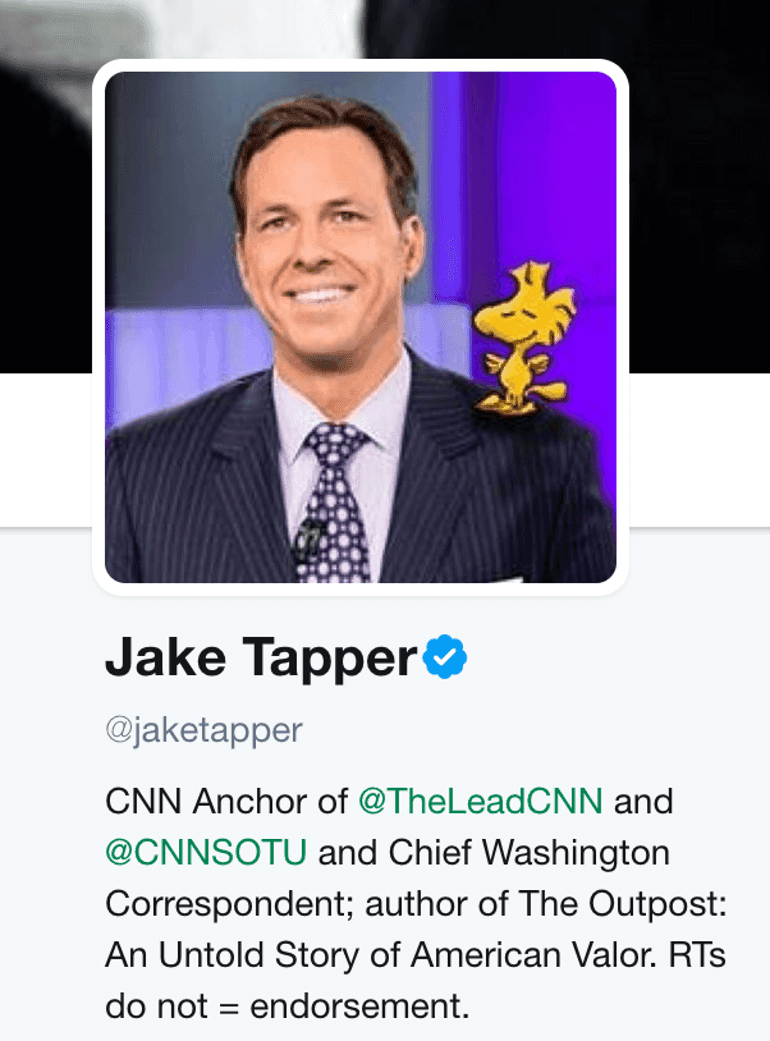 Those tiny bits of legal jargon do absolutely nothing to protect you or your company. They are nice to have, but don’t rely on them to save you or your company if a situation arises.
Those tiny bits of legal jargon do absolutely nothing to protect you or your company. They are nice to have, but don’t rely on them to save you or your company if a situation arises.
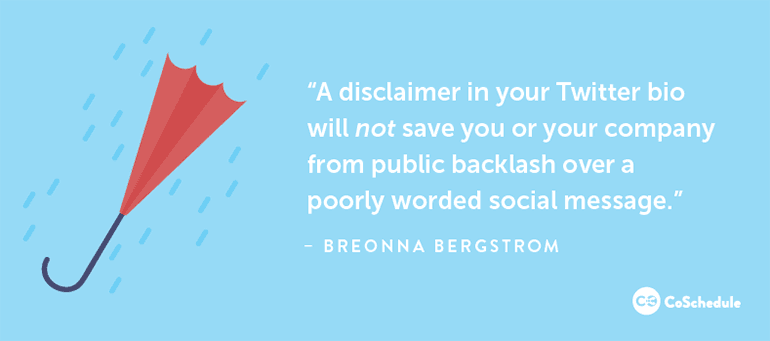 All of this information is not meant to scare you or to encourage you to create a policy that is locked down so tight it discourages your employees from posting online. Rather, the policy is there to help guide your employees and help them avoid mistakes, not shut down their social media posting.
All of this information is not meant to scare you or to encourage you to create a policy that is locked down so tight it discourages your employees from posting online. Rather, the policy is there to help guide your employees and help them avoid mistakes, not shut down their social media posting.
A #social #media #policy should help employees avoid mistakes.
Click To TweetSocial Media At Work
The next part of your social media policy template is a section dedicated to identifying appropriate social media usage at the office and during work hours. Some companies will have a very strict, no social media browsing while at the office, while some companies will be more relaxed and allow employees to browse social media as long as it doesn’t distract from their work. The policy that is in this example is strict but how your company determines your policy will be up to you.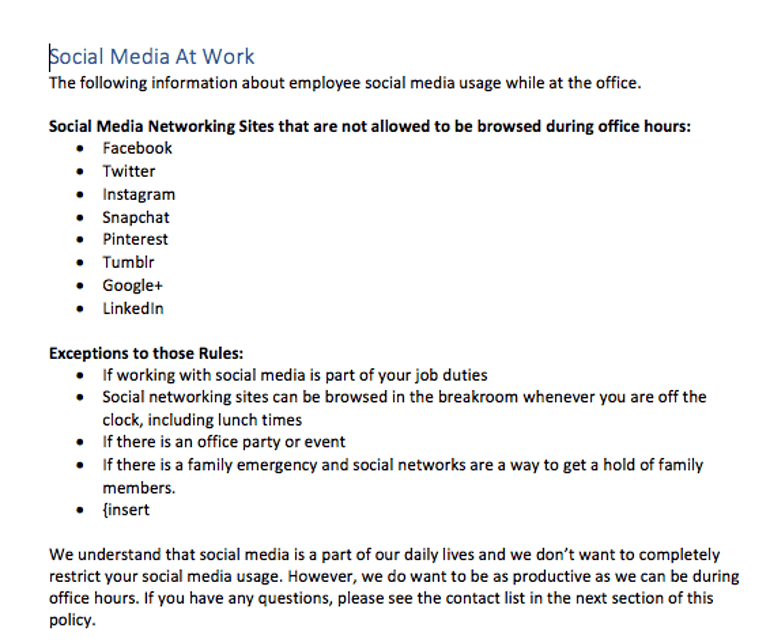
The Enforcement Of Your Social Media Policy
The rules of your social media policy need to be enforced. What that enforcement process looks like needs to be set up in your social media policy. It is better for your employees to know what is coming if rules are broken, then to sit and wonder what will happen. For this example, I broke down enforcement into three categories. One involves breaking the policy for social media office use, the second involves posting content that breaks the rules for acceptable content, and the third involves sending company information or other language that would be grounds for an immediate dismissal.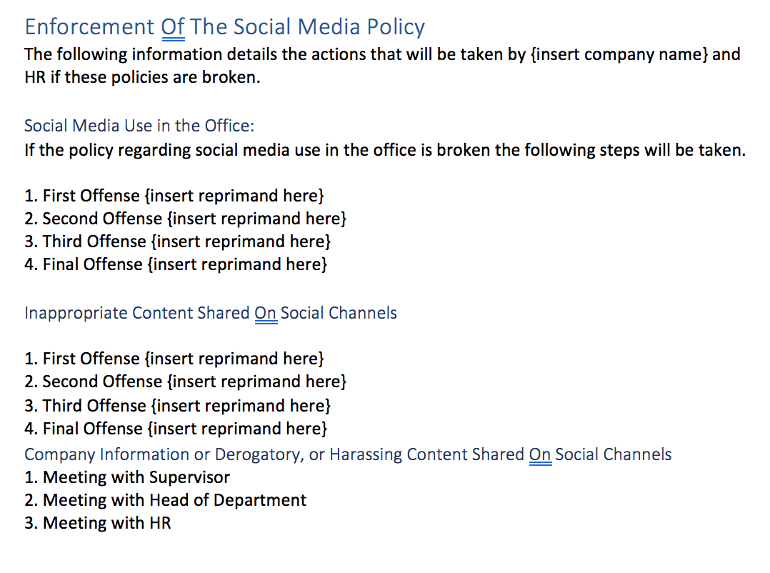 Each enforcement structure may differ depending on the types of rules you put into your policy. Work with HR and upper management to determine the course of action your company should take each time the policy is broken.
Each enforcement structure may differ depending on the types of rules you put into your policy. Work with HR and upper management to determine the course of action your company should take each time the policy is broken.
Where Should Staff Direct Questions About the Social Media Policy?
Your employees are going to have questions, whether it’s a simple “can I post this meme?” or more serious questions like “I posted a tweet and now people are upset, what do I do?” Having someone to turn to whether it’s a simple matter or a time of crisis can help make sure that your social media program is flowing smoothly. In your social media policy template, you’ll see a whole section dedicated to laying out what your chain of contact looks like. For this example we would have information all the way up to our CMO listed however, your’s may be different based on company and personal preferences.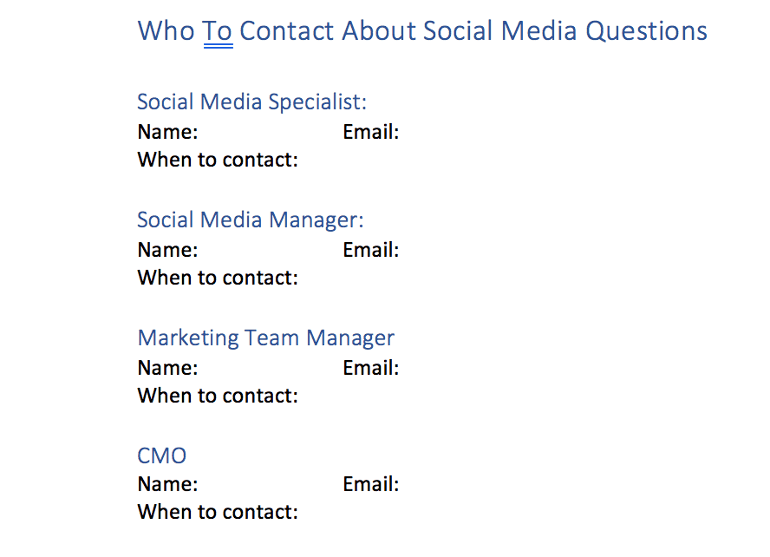
What Happens In A Crisis Situation?
Everyone is human and therefore mistakes happen. What do you do when those mistakes arise? More importantly, what do you do when those mistakes create a social media crisis situation for an employee? In your social media policy template, you’re going to layout the exact instructions that your employee will need to follow. The following is what I would have an employee do at Change Theatre Company. 1. Delete the tweet and issue a sincere apology. If something gets posted by one of your employees and it starts to cause a backlash, have your employee delete that message right away. It’s important to note that while the message may be gone, it very well could have been saved by someone else. Be prepared for it to resurface. The second thing your employee needs to do is issue a sincere apology. Not a regurgitated, robotic one either. You need to sincerely apologize for the offending message. People can tell in an instant if you’re just apologizing to save your skin. 2. Contact your social team. The next thing you need your employee to do is to contact your social media team and let them know what has happened. Once they have all the information they can prepare the company for any backlash they might face, and they’ll be able to advise said employee on what steps to take next in order to remedy the situation. Speaking of next steps… 3. Don't ignore angry messages. The worst thing you can do in terms of a social media crisis is to ignore angry messages. This adds gasoline to an already growing flame. Be sincere in your responses and remember the more genuine you can be with your responses the better. This is where I would end my instructions for my employees. However, based on your company and procedures your list may be longer. Work with your social media team to figure out the best process for you and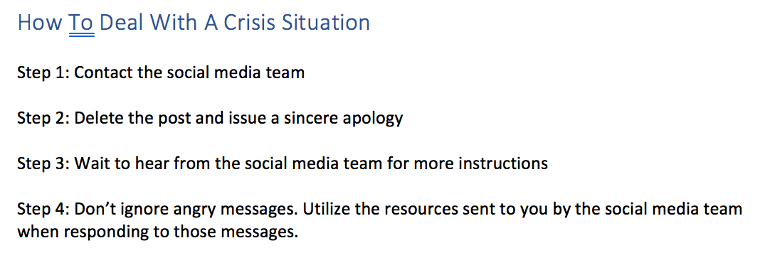 There is a second section of your crisis management involves contacts of people who need to be informed immediately if a crisis situation arises. These are the people who can put your crisis plan into action and try to control any damage that the company may suffer before it gets out of control.
There is a second section of your crisis management involves contacts of people who need to be informed immediately if a crisis situation arises. These are the people who can put your crisis plan into action and try to control any damage that the company may suffer before it gets out of control.
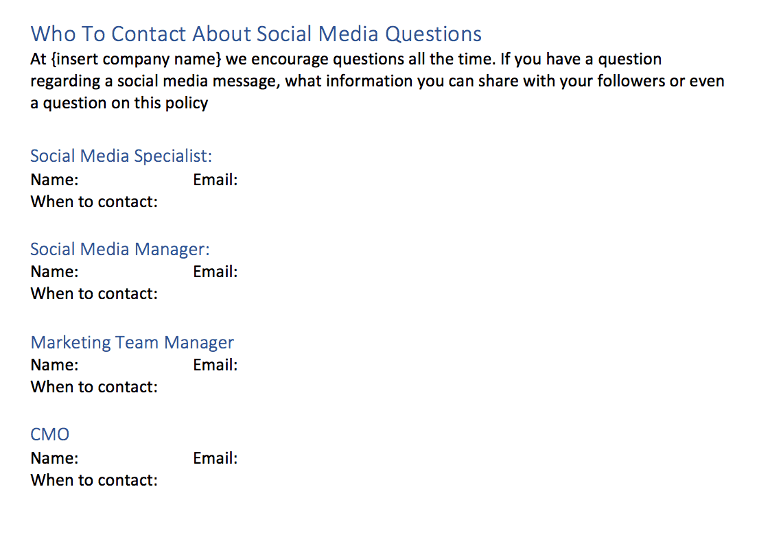
Managing Your Online Presence
Having resources at the end of your social media policy to help your employees manage their social presence will not only give them peace of mind about what to post but if they’re done right if will actually encourage them to post more. In your social media policy template is the last section for you to fill out. Here is an example of what I would want my management section to look like.Creating A Checklist Or Step List To Great Online Etiquette
Forbes has an amazing 12 step checklist to having great social media etiquette. Things have changed since the days of 12-course dinners and formal introductions. So I would put a short online etiquette list for your employees. For this example, I stuck to five major ideas. Your list could be longer like the Forbes list or shorter than my example. This list is mainly here to serve as a reminder to double-check that you’re sending the right things out into the mindset.
Your list could be longer like the Forbes list or shorter than my example. This list is mainly here to serve as a reminder to double-check that you’re sending the right things out into the mindset.
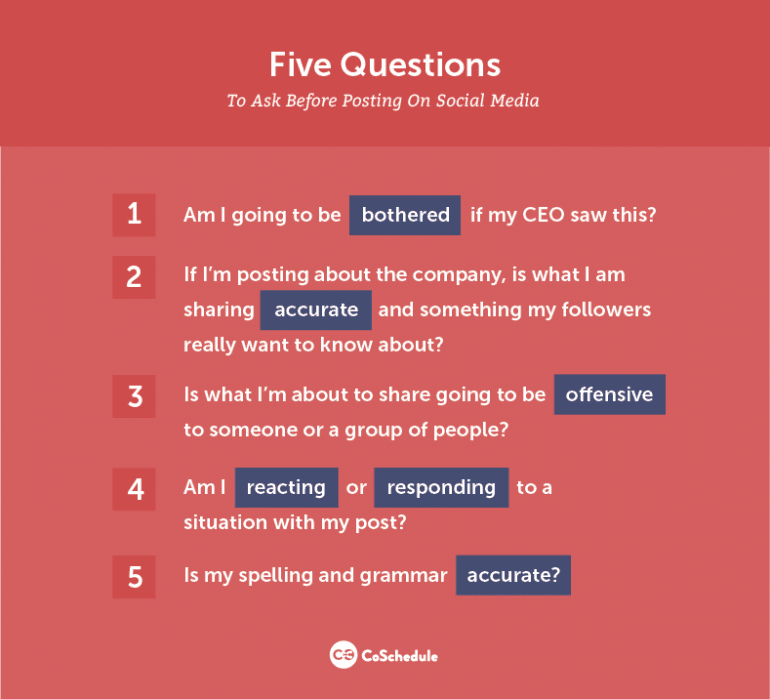
How To Deal With Online Complaints Or Questions
Never ever let your employees take complaints or questions into their own hands unless it’s part of their job to do so. For this example, I include a simple three-step process for my employees to follow if they see a question or complaint about the company.
Be Up Front About Who You Work For
You never want to be deceptive in your social media use so it’s important that your employees are upfront about who they work for. Intel has a great social media policy that highlights how employees can identify that they work for Intel. Usually, they have a disclaimer in their bio that they work for Intel and if they post about something work related they should use the hashtag #IAmIntel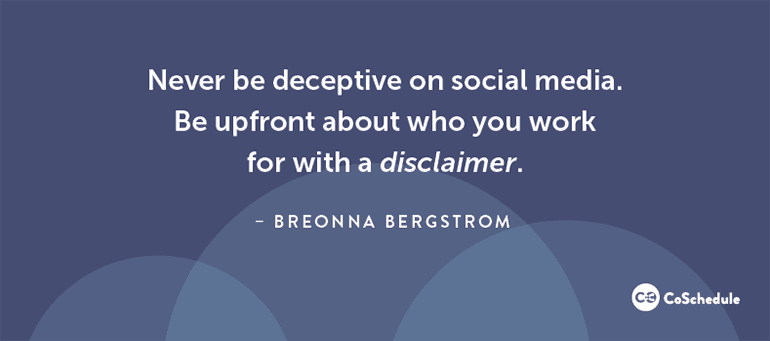 I used this same theory in creating our example social media policy. There is a section explaining what they should have in their social media bios and the hashtag they should use.
I used this same theory in creating our example social media policy. There is a section explaining what they should have in their social media bios and the hashtag they should use.

Four Real-World Social Media Policy and Business Guidelines for Inspiration
Now you’ve got your initial social media policy built. There may be more things you want to cover in your policy and that’s ok. But in case you need even more inspiration to create your policy check out some of these examples.Need inspiration for your own social media policy? Check out these examples.
Click To TweetExample: Coca-Cola
Coca-Cola is a massive Fortune 500 that has a huge social presence that needs to be managed from both a corporate and employee perspective. From corporate accounts to social media influencers, Coca-Cola outlines exactly what they expect from every aspect of their social presence. Coca-Cola does a great job outlining the traits they want their company to implement and showcase across their social channels. Check out their full social media policy document for inspiration: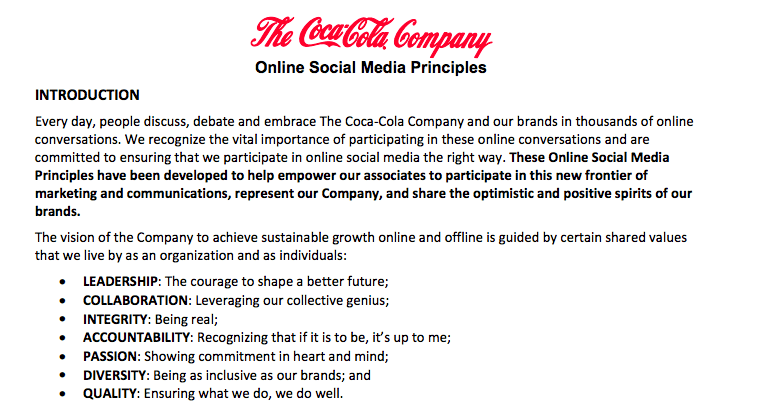
Example: Best Buy
I love the way that Best Buy phrased their social media policy when it comes to their employee’s social media presence. They’ve phrased their policy so it’s easy to understand by clearly outlining where Best Buy stands on their employee’s social media use. They highlight the fact that their employee’s responsibility to Best Buy doesn't end when their shift is over. Anything they post related to the company, they are held liable for. They also address the fact that employees need to respect the opinions of others with their “Honor Our Differences” policy that is a major feature in their social policy.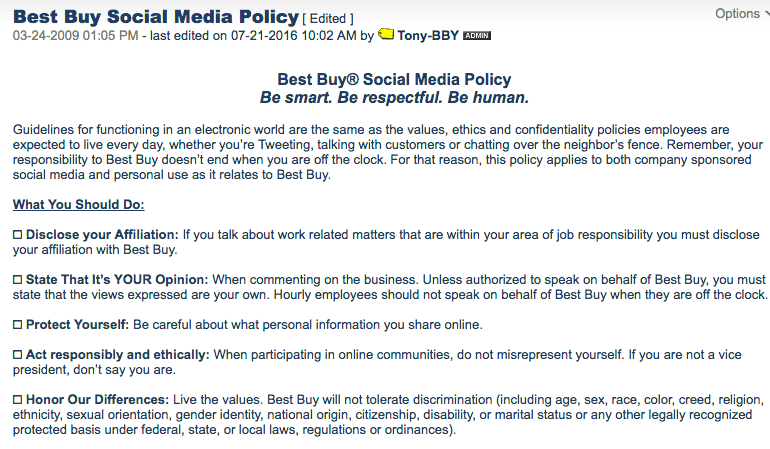
Example: The United States Air Force
It makes complete sense that the US Air Force would have an extensive social media policy. After all the information that is shared with these men, women and their families is sometimes incredibly sensitive. Their social media guide has to cover a lot of information from what they can post to who to contact about releasing certain information or even photos. However, they added some nice design flair with an almost infographic-like feel. If you have a designer available I would suggest trying a more visual approach to your social media policy. Not only are you going to help increase the read through rate, your employees will thank you for not making them stare at 20 pages of plain paper.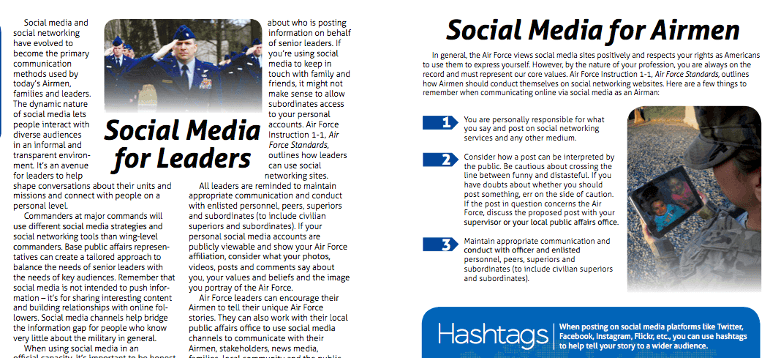
Example: Nordstroms
Nordstroms social media policy is brief compared to some of the other policies in our example list. However, Nordstroms main focus in on their customers and making sure that their privacy and the privacy of other employees is respected. Nordstroms also focuses on its endorsers reminding them to be upfront that they are part of the Nordstrom brand. If you are looking at using influencers on social media in any way, this would be a good policy to review.